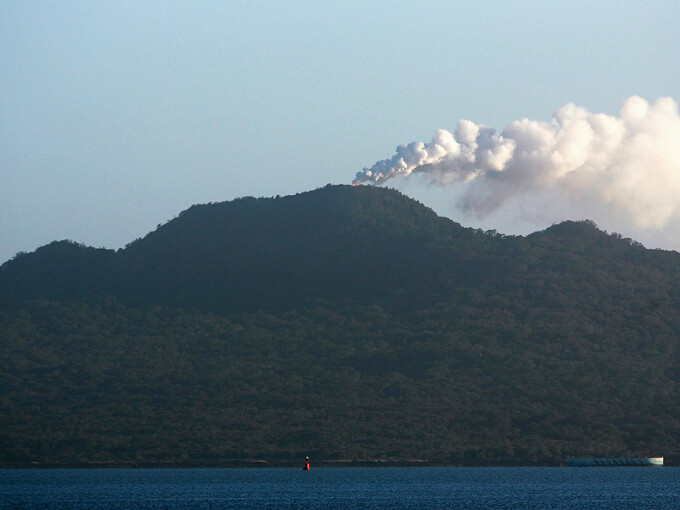Jul 25, 2019 People
Unpredictable, wild, reliable Rangitoto. A local fixture, framing every sunrise on the eastern shore, but now more visited by tourists than residents, it is — as American politician/poet Donald Rumsfeld might have put it — Auckland’s greatest unknown known.
Rangitoto was born from the actions of an ancient tribe of giants, as landforms so often are. This tribe (relates John White in The Ancient History of the Maori, His Mythology and Traditions — Nga-Ti-Whatua [Vol. XIII]) amused themselves in “games of throwing stones from hill to hill”. One of the giants, dared by his mates, drew a great hill “as a farmer would a turnip” and carried it across Titirangi before throwing it into the ocean between Takapuna and Motutapu.
Other stories speak of a falling-out between two tupua, strange fiery beings, dwellers on a great mountain. In a moment of We’re not yelling, your mother and I are just having a discussion, the couple failed to notice that their fire had gone out. The co-dependent couple cursed Mahuika, the fire goddess. She complained to Mataoho, the god of earthquakes and volcanoes, who promptly blew up the couple’s mountain home. The resulting crater was Lake Pupuke. The blast stranded the pair on Rangitoto, where their tears can be seen as mist on cold mornings.
Later, the Arawa waka arrived in the Hauraki Gulf, captained by Tamatekapua. At the island, rumours of adultery saw him come to blows with the captain of the Tainui canoe, Hoturoa. This left his face bloodied, and the island was named “Nga Rangi-i-totongia-a-Tamatekapua” (the day the blood of Tamatekapua was shed). The truncation is, of course, Rangitoto.
Still more stories suggest that Rangitoto’s origins lie a hundred kilometres below Auckland, where a great hotspot is responsible for all the volcanoes of Tamaki Makaurau, Rangitoto being the youngest, at 600 to 1000 years old.
Contested, fraught, stolen Rangitoto was acquired by the Crown in 1854 for the wildly extortionate price of £15. So readers can understand the depths of this skulduggery, this is equivalent to around $2300 in today’s money. It equates to just 0.24 per cent of the average Auckland house price in 2019. The traditional owners of Rangitoto are Ngai Tai ki Tamaki, who received a $12.7 million Treaty settlement from the Crown in 2018 for the forced acquisition and confiscation of their lands. They continue to assert their right to access over Rangitoto and Motutapu islands, with a case currently before the Supreme Court.
After its unfair acquisition, Rangitoto became Auckland’s economic servant. Its basalt helped build the foundations, and the wheel-maiming kerb-stones, of modern Auckland. Dying ships were broken on the northern shore; their remains are there still. Hardscrabble baches were built, never quite legally, and new baches were forbidden in 1937. Prisoners broke rocks and built roads. Wildfires flared, often lit by visitors who would do so as a way to signal how far they had travelled towards the summit. Possums, rats, cats and wallabies destroyed much of the wildlife and vegetation.
In 2011, after an eradication programme, the islands were declared pest-free. Endangered tieke (saddlebacks) now thrive there, and visitors are told to check themselves for any rats or mice or wallabies they may inadvertently be smuggling.
In person, Rangitoto is raw, calloused, strange, runnelled and studded with scoria. Secret caves lurk around corners; the ground sometimes seems to echo underfoot. The scolding of tieke is heard from the jungly scrub that grows in between alien barrens of sharp rocks. The island is clad in forest unusual anywhere else in New Zealand, composed almost entirely of a mutant strain of pohutukawa crossed with rata, which finds a foothold in the island’s hard basalt skin. Its summit is accessible by boardwalk and steps. There, the greenery plunges into the vast bowl of its crater, the size of a stadium. It is easy to imagine, as Maurice Gee did in Under the Mountain, terrible beings sheltering under it; alien worms of great size and power. Or maybe it’s just lava, which has equal destructive potential.
If Rangitoto ever erupts again, Auckland will just kind of stop, evacuated, the buildings and streets and economy suffocated under a blanket of ash. It would cost the country many, many billions of dollars. Upsides may include a fall in local property prices.
The photo above shows a mock eruption staged as a promotional stunt in 2007. Rangitoto might be extinct. It might be sleeping. No one really knows.
“It is unlikely Rangitoto will erupt again,” says GeoNet. “It could blow again,” says Stuff, citing University of Auckland associate professor of geology Phil Shane.
“It will almost certainly erupt again,” says the Herald, citing the Journal of Volcanology and Geothermal Research, but they’re talking about the whole Auckland volcanic field, not just Rangitoto.
This piece originally appeared in the July-August 2019 issue of Metro magazine, with the headline ‘Crater Face’.






